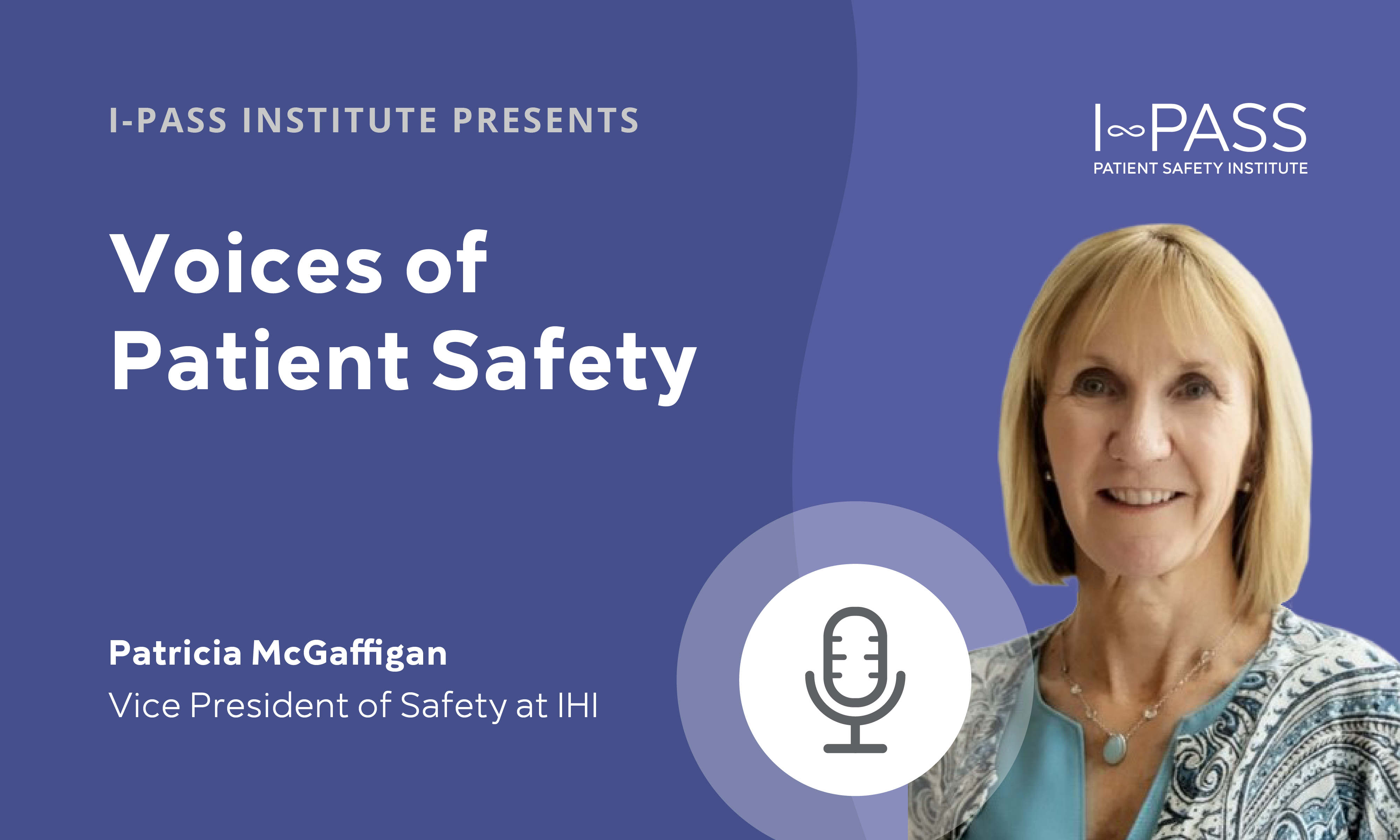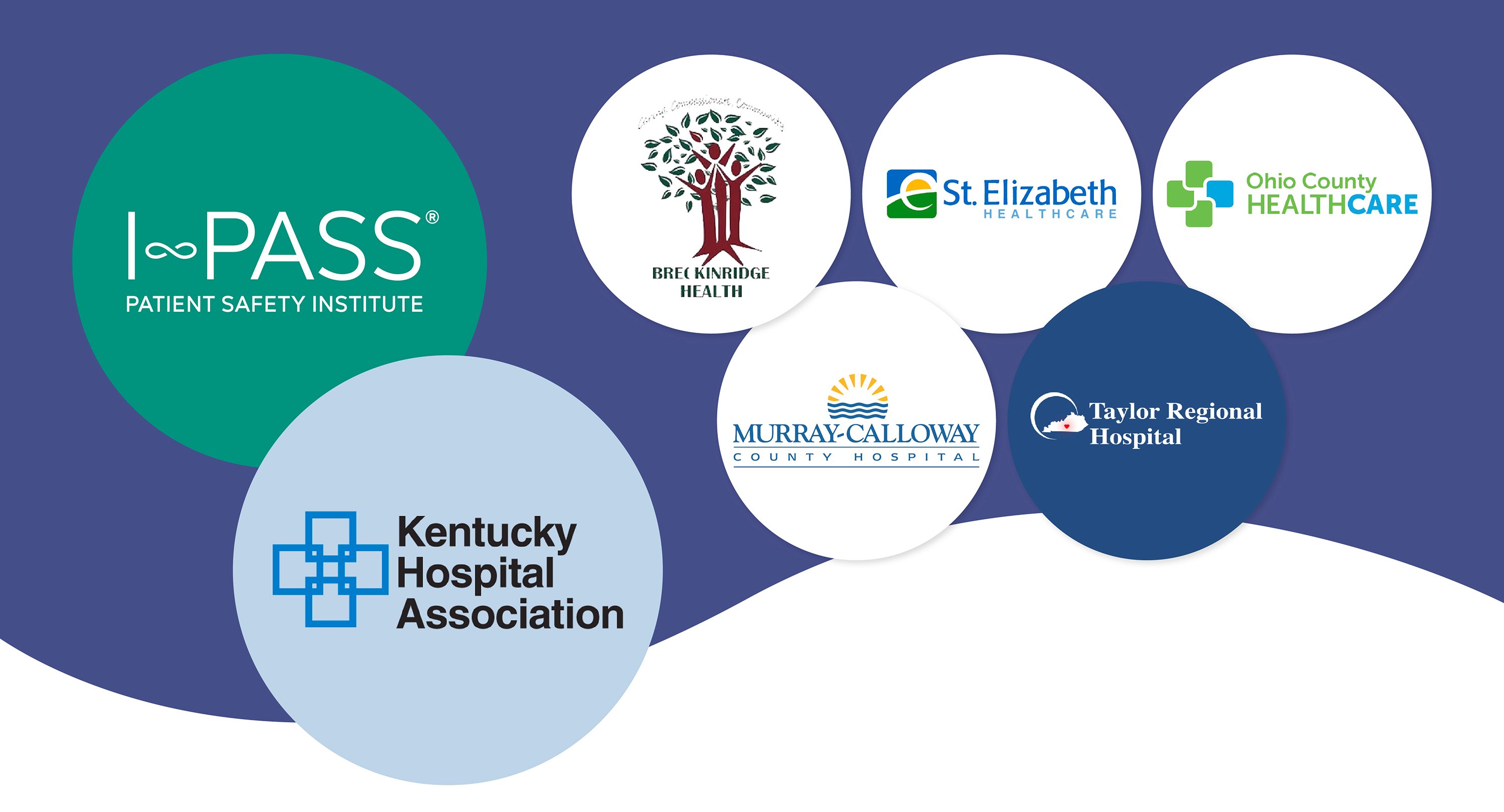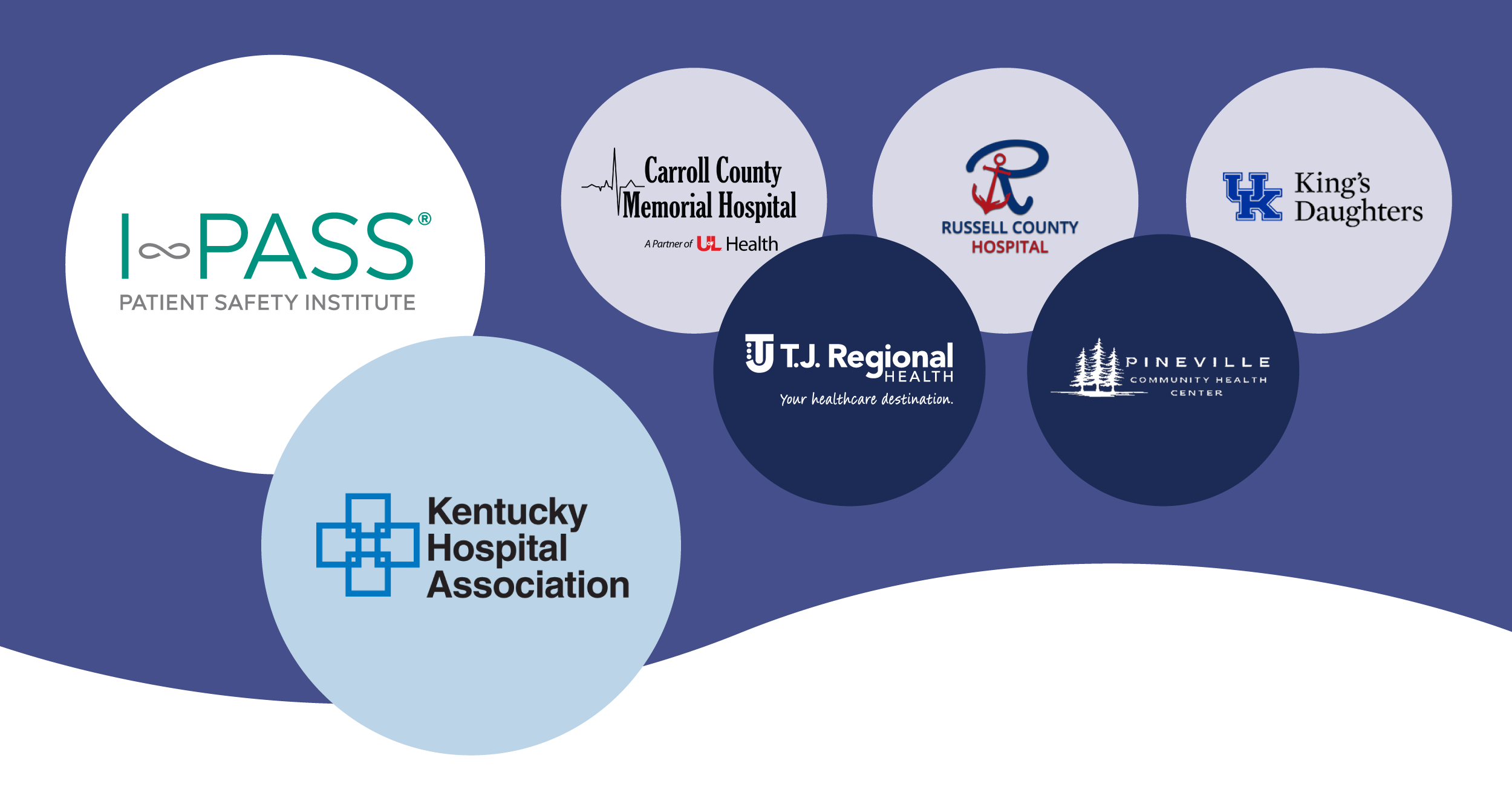For this edition of Voices of Patient Safety, we sat down with new I-PASS Board Member Patricia McGaffigan, who serves as the President of the Certification Board for Professionals in Patient Safety and Vice President of Safety at the Institute for Healthcare Improvement (IHI). Among her many roles, she serves as senior sponsor for the IHI’s Lucian Leape Institute and co-chair of the National Steering Committee for Patient Safety. We learned how Patricia’s extensive experience in clinical practice, academia, and medical technology innovation influenced her life’s work in advancing patient safety. With an emphasis on standardizing communication in clinical handoffs on a national level, Patricia explained how healthcare organizations can improve their commitment to patient safety through partnering with organizations like the I-PASS Institute.
Tell us about your professional background.
Upon graduation from nursing school, my clinical practice began in a pediatric critical care unit, and I quickly pursued my master's degree to become a pediatric clinical nurse specialist. For a couple of years, I worked full-time in two roles in clinical practice and academia while pursuing my doctoral degree. My next career move was a role in the medical device industry as a clinical educator helping customers understand the value and applications of pulse oximetry, an emerging technology at the time. I thought this might be a one-year role, however, it led to decades working across companies that were commercializing safety monitoring technologies and clinical decision support solutions.
Over the years, I interfaced regularly with the Anesthesia Patient Safety Foundation and leveraged resources from the nonprofit National Patient Safety Foundation (NPSF). When the NPSF relocated its offices to Boston, I jumped at the opportunity to join the organization in 2012 and served in roles as Interim President, Chief Operating Officer, and Senior Vice President of Programs prior to our merger with the IHI in 2017.
How did your experience with direct clinical care as an ICU nurse, and then as an educator, influence your commitment to patient safety?
I was working in a high-performing critical care setting with some of the sickest pediatric patients in the world, where patient and family presence and engagement was the norm. This focus on patient and family engagement shaped the values that I bring to my work in patient safety. My experience also gave me a perspective on what safety meant to patients and family members, which is different from how providers perceive it. In my roles as an educator in the device industry, I became increasingly aware of the importance of leveraging broad-scale partnerships across the healthcare industry to advance progress in safety.
How did your corporate roles prepare you to lead efforts at the NPSF and now at the IHI?
Those roles were instrumental in providing a clear understanding of how the healthcare ecosystem actually functions and in shaping the way that I evaluate customer and market needs and opportunities as a foundation for pursuing key strategies, relationships, and potential solutions. And working with business development partners puts a very clear lens on the market realities for today and moving upstream with a future-focused mindset. A lot of what makes solutions successful is understanding the need and identifying what’s getting in the way of optimal care. Lastly, I learned that it takes a lot of courage and persistence to be on the cutting edge of change. We very much live in a “right now results” mindset today, yet strategically architecting change requires recognition of what matters for long-term gains.
Nearly 25 years after the publication of To Err is Human, why is it critical for healthcare organizations and leaders to recommit to advancing patient safety?
This is something that I live and think about every single day in my work. We've definitely achieved some gains as a result of the impetus that To Err is Human created, yet these gains and progress have been uneven and proven fragile amid the pressures of the pandemic. Also, a lot of our focus has been on safety in the hospital setting versus safety across the entire continuum of care, which matters deeply because most of the care that patients receive occurs outside of the hospital. In the 25 years since To Err is Human, so much of our emphasis has been on addressing the sharp end-of-care variation that's clinical and technical in nature, which is certainly important. And yet, we know that safety is a system property, and it requires us to focus on improving the system, which I believe has been largely overlooked as we’ve depended upon individuals to practice safety. The way I think about this is that we commonly add on rooms to the house without necessarily focusing on ensuring that the foundation of the house is solid.
Which foundational areas should a health system focus on to advance patient safety?
The four foundational areas of the Safer Together National Action Plan to Advance Safety—culture, leadership and governance; patient and family engagement; workforce safety and wellbeing; and the learning system—are all interrelated, integral, and nonnegotiable if we are to transform and sustain safety. For example, we know that care is safer when we meaningfully engage patients and families in our safety work.
Do you believe any aspects of care need to radically change to reach zero harm?
Yes. First and foremost, we need to remember why we’re here. We need to ensure that the patient and family remain central to everything we do. The founder of IHI, Don Berwick, has a quote I hold close in all of my work: “We are guests in the lives of our patients.” It’s essential that we flip our mindsets from patients who exist for the healthcare industry to generate profits to recognizing that healthcare exists to service the needs of the persons we care for.
From your perspective, what factors make a patient safety intervention successful?
If we regard safety as a variable priority that comes and goes based on other organizational priorities, such as a pandemic, financial pressures, or artificial intelligence, we’ll continue to have the same conversations 25 years from now. My personal preference is to say that safety is more than a priority, it’s our purpose. And of course, central to a successful patient safety intervention is the use of improvement methods to test and understand whether a change is indeed an improvement, which is common across our work at IHI and the I-PASS Institute. Also, executives and governing body championship is certainly necessary for continuous improvement as we test and implement patient safety interventions. The organization must also provide clear line of sight across the workforce for why and how changes matter and engage the workforce, patients and families in the co-creation of solutions that will accomplish the desired outcome.
Since the pandemic, there’s been a noticeable shift to an increasingly contingent workforce (travel, per diem, and gig workers). How has this trend affected ongoing patient safety work?
Over recent years, we’ve experienced dramatic changes in the workforce with churn of staff and leaders, and the composition of the workforce is increasingly contingent. That’s why the constancy of purpose of leaders and all who work in healthcare around safety matters. We also have more of a multi-generational workforce, so there’s an incredible level of attention that needs to go into structuring communications and standardizing approaches across healthcare. Two years ago, for example, we conducted an innovation wave of work at IHI to understand what was happening in terms of selection, orientation, and onboarding of temporary nursing staff. We found there was no commonality in assessing baseline capabilities, orientation, or reporting, or structuring communications about safety. Ensuring continuity and standardization of certain practices is important to achieve necessary competencies for safety.
What could broader national standardization of communication in clinical handoffs do to help elevate the standard of care?
Communication is viewed by some as a squishy subject that’s not necessarily received the same level of attention as the clinical and technical fixes that we implement to improve care. I think there’s a lack of awareness of the extensive risks from ineffective communications, especially given all of the touchpoints that patients and families encounter and the extent of care fragmentation. Across all of the opportunities we have for safety, I think it has the most robust evidence of a need for improvement. We know that breakdowns of communication are at the heart and soul of every kind of fault line or potential harm; it's hard for me to think about a circumstance where this issue does not apply. Communication contributes dramatically to the quality of care or the potential risks and harms to patients and the workforce.
If we look across all our data on malpractice claims, and when we do a rigorous analysis of contributing factors to adverse events and preventable harm, there are vast opportunities to improve communications. We've got growing data that puts us in a position where structured communications should not be optional. The way we’ve been doing things is wildly insufficient for improving and sustaining safety. I believe I-PASS should become standard practice across healthcare. It’s one of the most universal evidence-based solutions for one of the most universal safety challenges that we have.
Do you predict that accrediting bodies will drive structured communication efforts?
Structured communication is probably one of the largest frontiers of opportunity that we have right now in safety and relates to virtually every safety challenge and opportunity. It’s not only relevant for shift transitions; it matters deeply for every transition of care team members and locations of care, agnostic of where care is given. If I were in charge of a healthcare system, this is one area that I would absolutely lift to the top, because it matters for care encounters and related communications everywhere.
Can you talk a little bit about your first impression of I-PASS?
The work of the I-PASS Study Group caught my eye very early on. There’s historically been variation in attention and training for transitions of care, and I-PASS demonstrated that there's a solution that can be applied in any setting to make care safer. And that care can and should meaningfully include the patient and family members. The I-PASS solution offers real-time, reliable organizing of communications that enables providers to be tightly coupled with the patient's needs so they can provide the best care possible. I get super excited about the patient and family engagement work and it’s one of the reasons why I leaned into the opportunity to work with I-PASS. They have the breadth of evidence as well as the courage and ingenuity to take on the challenging notion of structured communication. This is a group that I want to be affiliated with, and I believe the impact of the I-PASS solution is integral to transforming safety.
What is different about the I-PASS framework compared to other patient safety initiatives?
The framing of I-PASS is the biggest distinction. The first step in the mnemonic—illness severity—raises and calls attention; it’s an early warning system to pinpoint what’s most concerning. The patient summary and action list are dynamic and have real-time properties. I've heard from many nurses that they get frustrated with the poor quality of a shift report. I-PASS keeps people grounded in the moment and raises the level of critical thinking in a structured way that concludes with the vital synthesis step. It’s an outstanding approach to becoming highly reliable during handovers and care transitions.
Which patient safety work are you most proud to have led or been involved in?
I’m proud of the work and impact of the National Steering Committee for Patient Safety, which created the National Action Plan. It began with a collaboration of 27 national organizations, including six federal agencies, healthcare delivery systems, patient and family partners, patient and safety experts, and others to address an unmet need to collaborate on the creation of a National Action Plan for Safety. We’ve moved into essential yet largely undervalued realms of foundations for safety, and now we have healthcare organizations within and beyond the United States that are anchoring their safety strategies using the National Action Plan. Many elements have been carried into the proposed Centers for Medicare & Medicaid Services Patient Safety Structural Measure, which is currently under review. What healthcare needs is more alignment, cooperation, and collaboration to catalyze a focus on ensuring that safety is truly a core value, and I’m hopeful that this will help move us from “one hospital at a time” improvement to scaling sustainable progress for the safety of patients and those who care for them.
Additionally, as the President of the Certification Board for Professionals in Patient Safety, I’m proud that we've certified close to 6,500 individuals from around the world in patient safety. By this fall, we expect that this community will include certification of 1000 medical students the University of North Texas Health Science Center’s Texas College of Osteopathic Medicine, which means that graduates of their program enter residencies with demonstrated competencies in safety. They’ve been groundbreaking in their commitment and their approach to preparing future physicians to provide and lead safe care and caring.
What are you currently reading?
Since it was published five years ago, I reread Still Not Safe: Patient Safety and the Middle-Managing of American Medicine by Kathleen Sutcliffe and Bob Wears every March for Patient Safety Awareness Week. It describes how healthcare has clear misses and opportunities to improve safety. For example, while the focus on the realities of human fallibility because of To Err is Human is important, we’ve drifted from earlier years when the critical role of safety scientists and human factors, systems, and resilience engineering experts were embraced by the healthcare community. We’ve largely medicalized safety and focused on reacting to errors without leveraging the broad expertise that is needed to intentionally design safe systems that optimize human performance, such as the I-PASS solution. While it’s somewhat sobering to reflect on these realities on the occasion of the silver anniversary of To Err is Human, I have hope that we’re at a critical reorientation point to do what we know is necessary to transform safety.





